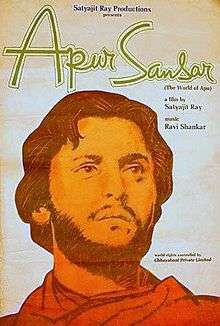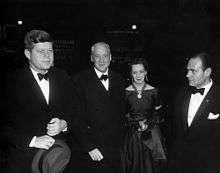The World of Apu
| The World of Apu | |
|---|---|
 Film poster | |
| Apur Sansar | |
| Directed by | Satyajit Ray |
| Produced by | Satyajit Ray |
| Written by | Satyajit Ray |
| Based on |
Apur sansar by Bibhutibhushan Bandopadhyay |
| Starring |
Soumitra Chatterjee, Sharmila Tagore, Alok Chakravarty, Swapan Mukherjee |
| Cinematography | Subrata Mitra |
Release dates |
|
Running time | 107 minutes |
| Country | India |
| Language | Bengali |
The World of Apu (Bengali: Apur Sansar) is a Bengali drama film directed by Satyajit Ray. It is the third part of The Apu Trilogy, about the childhood and early adulthood of a young Bengali named Apu in the early twentieth century Indian subcontinent. The film is based on the last two-thirds of the 1932 Bengali novel, Aparajito, by Bibhutibhushan Bandopadhyay.
Released in 1959, The World of Apu focuses on Apu's adult life, and also introduces the actors Soumitra Chatterjee and Sharmila Tagore, who would go on to appear in many subsequent Ray films. The film won the National Film Award for Best Feature Film and several international awards, including the Sutherland Award for Best Original And Imaginative Film and National Board of Review Award for Best Foreign Language Film. The World of Apu has been influential across the world and is frequently listed among the greatest films of all time.[1]
Synopsis
Apurbo Kumar Roy (Apu) (Soumitra Chatterjee) is an unemployed graduate living in a rented room in Calcutta. Despite his teacher's advice to go to university, he is unable to do so because he can't afford it. He tries to find a job, while barely getting by providing private tutoring. His main passion is writing a novel, partially based on his own life, hoping to get it published some day. One day, he meets his old friend Pulu, who coaxes him to join him on a trip to his village in Khulna to attend the marriage of a cousin named Aparna (Sharmila Tagore).
On the day of the marriage, it is revealed that the bridegroom has a serious mental disorder. The bride's mother cancels the marriage, despite the father's protests. He and the other villagers believe, according to prevalent Hindu tradition, that the young bride must be wedded off during the previously appointed auspicious hour, otherwise, she will have to remain unmarried all her life. Apu, after initially refusing when requested by a few villagers, ultimately decides to take Pulu's advice and come to the rescue of the bride by agreeing to marry her. He returns with Aparna to his apartment in Calcutta after the wedding. He takes up a clerical job, and a loving relationship begins to bloom between them. Yet, the young couple's blissful days are cut short when Aparna dies while giving birth to their son, Kajal. Apu is overcome with grief and holds the child responsible for his wife's death.
He shuns his worldly responsibilities and becomes a recluse – travelling to different corners of India, while the child is left with his maternal grandparents. Meanwhile, Apu throws away his manuscript for the novel he had been writing over the years. A few years later, Pulu finds Kajal growing wild and uncared for. He then seeks out Apu, who is working at a mining quarry and advises Apu one last time to take up his fatherly responsibility. At last, Apu decides to come back to reality and reunite with his son. When he reaches his in-laws' place, Kajal, having seen him for the first time in his life, at first does not accept him as a father. Eventually, he accepts Apu as a friend and they return to Calcutta together to start life afresh.
Cast
- Soumitra Chatterjee as Apu (Apurba Kumar Roy)
- Sharmila Tagore as Aparna, Apu's wife
- Swapan Mukherjee as Pulu
- Alok Chakravarty as Kajal
- Sefalika Devi as Pulu's wife
- Dhiresh Majumdar as Sasinarayan
- Dhiren Ghosh as the landlord
Production
Ray wanted fresh faces again for the film like other two films in the Apu Trilogy and thus he started auditioning. In others films he made in between, like Parash Pathar (1958) and Jalsaghar (1958), he did work with professional actors like Soumitra Chatterjee, a radio announcer and a stage actor who, with doyen of Bengali theatre Sisir Bhaduri, had first auditioned for the role of the adolescent Apu in Aparajito (1956). Though Ray thought he had the right look, he found him too old for the role. Ray remembered him and offered the role of adult Apu two years later. [2] Chatterjee was still unaware that he had already been selected for the title role. He had gone on the sets of Ray's fourth film, Jalsaghar, to watch the shoot. That day, while he was leaving the sets, Ray called him over and introduced him to actor Chhabi Biswas, saying, "This is Soumitra Chattopadhyay; he's playing Apu in my next film Apur Sansar", leaving him surprised.[3] Ray however had a tough time finding an actress for the female lead Aparna. He even placed an ad was placed in a local daily asking for photographs from girls between ages of 15 and 17. There were over a thousand responses to the ad, but Ray found none of them worth auditioning. This was when Ray came to know of a young girl, Sharmila Tagore, who had recently performed at a dance recital at Children's Little Theatre (CLT) in Kolkata. She is related to poet Rabindranath Tagore, and subsequently auditioned and was selected.[2]
Despite being selected, as a debutant actor, Chatterjee was nevertheless unsure of his career choice and especially his looks, as he didn't consider himself photogenic. However, on 9 August 1958, when the first shot of the film was given an okay in one take, he realized he had found his vocation.[4]
Awards
- National Film Awards (India)
- Winner – 1960 – Sutherland Award for Best Original And Imaginative Film
- Winner – 1960 – Diploma Of Merit
- National Board of Review Awards (United States)
- Winner – 1960 – Best Foreign Film
- British Academy Film Awards (United Kingdom)
- Nominated – 1962 – BAFTA Award for Best Film
Reception and legacy

At Rotten Tomatoes, The World of Apu has a 100% fresh rating based on an aggregate of 21 reviews.[6] In 1992, Sight & Sound (the British Film Institute's film magazine) ranked The Apu Trilogy at #88 in its Critics' Poll list of all-time greatest films.[7] In 2002, a combined list of Sight & Sound critics' and directors' poll results ranked The World of Apu at #93 in the list.[8] In 1998, the Asian film magazine Cinemaya's critics' poll of all-time greatest films ranked The Apu Trilogy at #7 on the list.[9] In 1999, The Village Voice ranked The Apu Trilogy at #54 in its Top 250 "Best Films of the Century" list, based on a poll of critics.[10] The film was selected as the Indian entry for the Best Foreign Language Film at the 32nd Academy Awards, but was not accepted as a nominee.[11]
In 1996, The World of Apu was included in Movieline Magazine's "100 Greatest Foreign Films".[12][13] In 2001, film critic Roger Ebert included The Apu Trilogy in his list of "100 Great Movies" of all time.[14] In 2002, The World of Apu featured in "The New York Times Guide to the Best 1,000 Movies Ever Made".[15] In 2005, The Apu Trilogy was included in Time magazine's All-Time 100 best movies list.[16]
The World of Apu has been influential across the world. In Gregory Nava's 1995 film My Family, the final scene is duplicated from the final scene of Apur Sansar. The film's influence can also be seen in famous works such as Martin Scorsese's 1976 New Hollywood film Taxi Driver, several Philip Kaufman films,[1] and Key's 2004 Japanese visual novel Clannad.[17] References to The World of Apu are also found in several films by European filmmaker Jean-Luc Godard,[18] and in Paul Auster's 2008 novel Man in the Dark where two characters have a discussion about the film.[19]
Preservation
The Academy Film Archive preserved the entire Apu Trilogy in 1996, including Apur Sansar.
See also
- The Apu Trilogy
- Satyajit Ray
- Bengali cinema
- Cinema of India
- Writer's block
- List of submissions to the 32nd Academy Awards for Best Foreign Language Film
- List of Indian submissions for the Academy Award for Best Foreign Language Film
References
Notes
- 1 2 Steve Palopoli (8–15 October 2003). "Ghost 'World': The influential presence of Satyajit Ray's 'The World of Apu' lingers over some of the greatest American films of all time". Metroactive. Retrieved 2010-01-16.
- 1 2 Ray 1996, p. 131.
- ↑ "Soumitra Chatterjee on his master Satyajit Ray". The Times of India. 9 May 2014. Retrieved 2014-05-21.
- ↑ Anuradha SenGupta (29 June 2008). "Being Soumitra Chatterjee: Star of the East". CNN-IBN. Retrieved 2014-05-21.
- ↑ "7th National Film Awards" (PDF). Directorate of Film Festivals. Retrieved 4 September 2011.
- ↑ The World of Apu at Rotten Tomatoes
- ↑ Aaron and Mark Caldwell (2004). "Sight and Sound". Top 100 Movie Lists. Archived from the original on 2009-07-29. Retrieved 2009-04-19.
- ↑ "2002 Sight & Sound Top Films Survey of 253 International Critics & Film Directors". Cinemacom. 2002. Retrieved 2009-04-19.
- ↑ Totaro, Donato (31 January 2003). "The "Sight & Sound" of Canons". Offscreen Journal. Canada Council for the Arts. Retrieved 2009-04-19.
- ↑ "Take One: The First Annual Village Voice Film Critics' Poll". The Village Voice. 1999. Archived from the original on 2007-08-26. Retrieved 2006-07-27.
- ↑ Margaret Herrick Library, Academy of Motion Picture Arts and Sciences
- ↑ "100 Greatest Foreign Films by Movieline Magazine". Filmsite.org. Retrieved 2009-04-19.
- ↑ "Movieline's 100 Best Foreign Films". GreenCine. 6 April 2008. Retrieved 2009-04-19.
- ↑ Roger Ebert (4 March 2001). "The Apu Trilogy (1959)". rogerebert.com. Retrieved 2009-04-19.
- ↑ The Best 1,000 Movies Ever Made, THE FILM CRITICS OF THE NEW YORK TIMES, The New York Times, 2002
- ↑ "All-time 100 Movies". Time. Time Inc. 2005-02-12. Retrieved 2008-05-19.
- ↑ Erin Finnegan (11 January 2010). "Shelf Life: Road to El Cazador". Anime News Network. Retrieved 2010-01-16.
- ↑ André Habib. "Before and After:Origins and Death in the Work of Jean-Luc Godard". Senses of Cinema. Archived from the original on 2006-06-14. Retrieved 2006-06-29.
- ↑ Douglas Kennedy (19 September 2008). "Man in the Dark, by Paul Auster: Reflections from a hall of mirrors where the present changes shape". London: The Independent. Retrieved 2009-07-09.
Bibliography
- Ray, Satyajit (1996). My Years with Apu. Penguin Books India. ISBN 978-0-14-024780-0.
External links
- Apur Sansar at the Internet Movie Database
- Apur Sansar at SatyajitRay.org